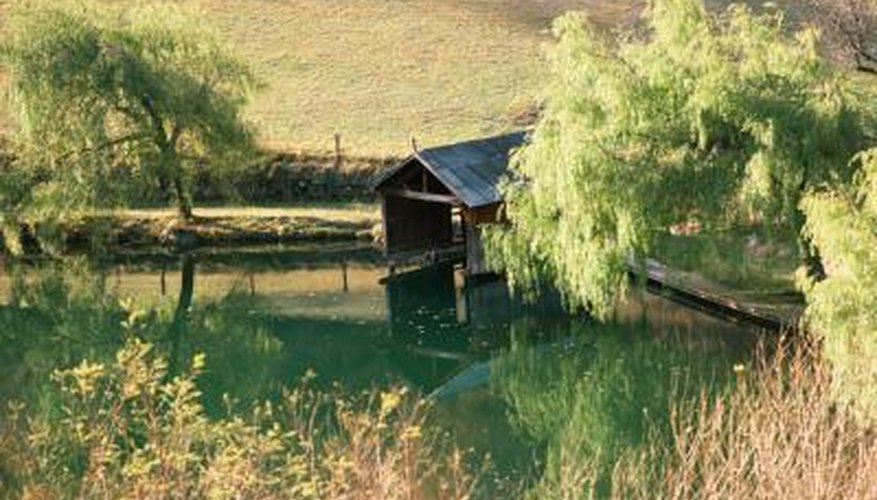Willow trees are often regarded as stately, regal trees that visually soften landscapes with their billowing forms. The truth is that willow trees are generally short-lived trees, prone to weak wood and a host of disease and pest problems. Caterpillars are just one of several insects that may feed on the leaves or bark of willows. A few of these caterpillars can cause extensive damage and require treatment.
European gypsy moth larva
The European gypsy moth is destructive in its larval stage. A single hungry caterpillar may eat a 30 cm by 30 cm area (1 square foot) of leaves per day. These pests feed on the leaves of willow trees, as well as fruit trees, aspen, birch, cottonwood, oak, poplar and other trees. They can quickly defoliate an entire tree, leaving it vulnerable to disease and death. Gypsy moth caterpillars are black and hairy when they first emerge. Later they become grey or yellow mottled, with bristly hairs and a pattern of blue and red dots on their backs. Control gypsy moths by burning or destroying their egg sacks and picking off caterpillars by hand. Treat infected trees with insecticides and bacterial controls labelled for use with the gypsy moth.
- The European gypsy moth is destructive in its larval stage.
- A single hungry caterpillar may eat a 30 cm by 30 cm area (1 square foot) of leaves per day.
Eastern tent caterpillar
The Eastern tent caterpillar's favoured foods include the leaves of crab apple, wild cherry and choke cherry trees, but it also feeds on the leaves of willow trees. This caterpillar is recognised by its black head and body with many brown and white markings. A white stripe runs from its head to its tail. Eastern tent caterpillars build white, gauzy tents of silk in the crotches of trees, where they live when not feeding. Insects and birds control these caterpillars, but they occasionally cause extensive damage to trees. Control them with Bacillus thuringiensis var. kurstaki, known as Bt. This bacterium doesn't harm people, animals or other insects, but kills caterpillars. Bt is available in formulas for different types of insects; read the label to ensure you're buying the right kind, and spray it thoroughly on the leaves.
- The Eastern tent caterpillar's favoured foods include the leaves of crab apple, wild cherry and choke cherry trees, but it also feeds on the leaves of willow trees.
- Eastern tent caterpillars build white, gauzy tents of silk in the crotches of trees, where they live when not feeding.
Polyphemus moth larva
Identify the Polyphemus moth larva by its fat, light-green body covered with fine hairs. This caterpillar has an accordion-like body that appears to be pushed together at the ends. It grows 10 cm (4 inches) long and feeds on the leaves of willow, apple, maple, hickory, and birch trees, among others. It produces a papery, rounded cocoon in late summer and emerges in the spring as a large silk moth. Controls are rarely necessary.
- Identify the Polyphemus moth larva by its fat, light-green body covered with fine hairs.
Cecropia moth larva
The Cecropia moth larva grow 10 cm (4 inches) long and almost 1.8 cm (3/4 inch) wide. These caterpillars are green, or greenish-blue, with orange and yellow tubercules on the back and many smaller blue or bluish-white tubercules along the sides. These larva feed on the leaves of many trees, such as willow, pecan, elm, birch, lilac and wild cherry. Their larval period lasts 35 to 60 days, after which they overwinter in a cocoon until the following spring. These caterpillars rarely do enough damage to warrant controls.
- The Cecropia moth larva grow 10 cm (4 inches) long and almost 1.8 cm (3/4 inch) wide.
- These larva feed on the leaves of many trees, such as willow, pecan, elm, birch, lilac and wild cherry.
